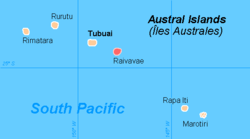Raivavae
Raivavae | |
|---|---|
 NASA astronaut photo of Raivavae island, 2001 | |
 | |
| Coordinates: 23°52′09″S 147°39′49″W / 23.869167°S 147.663611°W | |
| Country | France |
| Overseas collectivity | French Polynesia |
| Subdivision | Austral Islands |
| Area 1 | 17.9 km2 (6.9 sq mi) |
| Population (2022)[1] | 900 |
| • Density | 50/km2 (130/sq mi) |
| Time zone | UTC−10:00 |
| INSEE/Postal code | 98739 /98750 |
| Elevation | 0–437 m (0–1,434 ft) |
| 1 French Land Register data, which excludes lakes, ponds, glaciers > 1 km2 (0.386 sq mi or 247 acres) and river estuaries. | |
Raivavae (Tahitian: Ra‘ivāvae /ra.ʔi.va:va.e/) is one of the Austral Islands in French Polynesia. Its total land area including offshore islets is 17.9 km2 (6.9 sq mi).[2]: 205 At the 2022 census, it had a population of 900.[1] The island is of volcanic origin, and rises to 437 metres (1,434 ft) elevation at Mont Hiro.[2]: 243
History
[edit]The first sighting by Europeans was recorded by the Spanish naval officer Tomás Gayangos on board of the frigate El Aguila on 5 February 1775. Gayangos had taken over the command of the expedition of Domingo de Bonechea of 1774 after his death in Tahiti and was returning to the Viceroyalty of Peru.[3] The main source describing this sighting is that of José Andía y Varela, pilot of the packet boat Jupiter that accompanied El Aguila in this return trip. On 6 February, a boat was sent in, and made contact with the inhabitants at the shore edge, but landing was not made. Raivavae was charted as Santa Rosa by the Spaniards, who recorded as Oraibaba the name of the island said by the inhabitants.[4][5][6]
The island was annexed by France in 1880.
Geography
[edit]
Raivavae is a volcanic island that culminates with Mount Hiro at an altitude of 437 meters. Its land area is 16 km2. It is surrounded by a fairly large lagoon, but smaller than that of Tubuai. The surrounding coral reef comprises twenty-eight motu (islets). It is 630 km southeast of Tahiti.
Raivavae lies in the Cook-Austral volcanic chain, a series of submarine volcanoes and volcanic islands that stretches along the south of the Pacific Plate. The central island of Raivavae was formed from a hotspot on the Pacific Plate, whose magma production ended about 6.5 million years ago.[7]
The main island has four villages: Anatonu on the north coast, Rairua and Mahanatoa on the west coast, and Vaiuru on the east coast.
The native language of Raivavae is a variant of the Austral language called Reo Raivavae.[8]
Administration
[edit]The islands of Raivavae are administratively within the commune with the same name. Raivavae consists of the following associated communes:[9]
See also
[edit]References
[edit]- ^ a b "Les résultats du recensement de la population 2022 de Polynésie française" [Results of the 2022 population census of French Polynesia] (PDF) (in French). Institut de la statistique de la Polynésie française. January 2023.
- ^ a b Environnement marin des îles Australes
- ^ Salmond, Anne (2010). Aphrodite's Island. Berkeley: University of California Press. pp. 355. ISBN 9780520261143.
- ^ Andía y Varela, José Relación del viaje hecho a la isla de Amat, por otro nombre Otahiti, y descubrimiento de las islas adyacentes en los años 1774 y 1775, Barcelona, 1947, p.83
- ^ Sharp, Andrew The discovery of the Pacific Islands Oxford, 1960, p.126,127
- ^ Corney, Bolton Granvill The quest and occupation of Tahiti by emissaries of Spain during the years 1772-1776, London, 1913, Vol I, p.XLVII
- ^ Bonneville, Alain (12 September 2012). "The Cook-Austral volcanic chain". MantlePlumes.org. Archived from the original on 13 October 2024. Retrieved 13 October 2024.
- ^ Jean-Michel Charpentier; Alexandre François (2015). Université de la Polynésie française (ed.). Atlas Linguistique de Polynésie Française — Linguistic Atlas of French Polynesia. Papeete, Tahiti. pp. 2562 (total). ISBN 978-3-11-026035-9. atlas.
{{cite book}}: CS1 maint: location missing publisher (link) - ^ Décret n°72-407 du 17 mai 1972 portant création de communes dans le territoire de la Polynésie française, Légifrance


